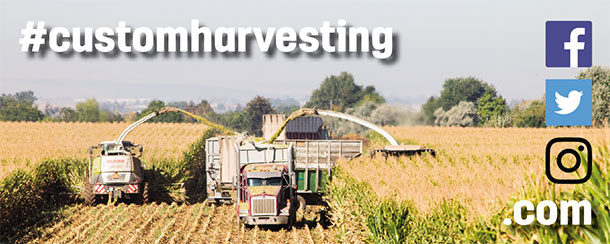While the occasional or small shortage in customers may not be a reason for concern, repeated shortages should trigger you to look into the circumstances more closely and work to reverse the trend.
One reason for a lack of customers may be due to poor marketing. Farmers may be unaware of your business, the specific services you provide or how you can help them improve their business. This article will focus on the marketing aspect – that is, how to improve your marketing to gain customers.
Marketing messages
First, you need to be able to clearly articulate the advantages of hiring a custom harvester to potential customers. When talking with farmers who may be interested in hiring you, take the time to learn about their farm and management style. This allows you to identify what’s important to them, where gaps may exist in their current harvesting operations and what they are looking for from you.
In doing so, you’ll be able to better convey how your services will solve their problem or improve their business or operations.
Outlined below are six aspects you can discuss:
-
Free up labor for remaining enterprises. Hiring a custom operator allows producers, and their employees, the time to attend to details in other parts of the business, developing specialized knowledge instead of being a “jack-of-all trades.” Also, a farmer may not be put in the situation of having to have unqualified employees driving equipment.
-
Free up management for remaining enterprises. By not having to personally attend to crop harvesting, a farmer gains time to analyze data and make more informed decisions. In the long run, an increased focus on management activities can be more valuable to the farm business.
Additionally, a farmer may have added time to take advantage of education opportunities, also contributing to improved farm business management.
-
Concentrate efforts in fewer enterprises. This is also referred to as specialization. Just as you specialize in crop harvesting, the farmers who hire custom harvesters can focus the use of their resources – equipment, finances, in addition to labor – on fewer enterprises.
For instance, a dairy producer can focus on their milking enterprise and replacement heifers, while hog or beef producers could concentrate on their livestock enterprise.
-
Obtain higher-quality products. Custom operators provide specialized knowledge and expertise in the services they perform. This should translate into improved quality of harvested crops.
Whether through more timely performance of harvesting activities, more efficient machinery and equipment for the size of the job, or complementary services such as bunk packing, your harvesting services provide consistent and improved crop quality.
-
Increased production. This relates to the previous point. Farmers who are receiving higher-quality forages as a result of custom harvesting may see an increase or improvement of production in their milking or livestock enterprise. Better weight gain, increased milk production or higher milk component levels should lead to the generation of more gross revenue.
-
Reduce machinery and equipment expenses. Hiring custom operators relieves farmers from the need to own and properly maintain machinery used for a short period of time, owning machinery larger than needed for other farming activities in an effort to achieve timely harvest or buying specialized equipment that may only be needed for one type of crop.
Beyond possible principal loan payments, cost avoided by not owning machinery include depreciation, interest, repairs, oil, fuel, taxes, insurance and housing.
Marketing tools
Once you’re confident in your ability to communicate the benefits you bring to a farmer, you can turn your attention to specific marketing activities – beginning with a look at the marketing tools you use. These include websites, social media and more traditional tools such as flyers, brochures, print advertisements, networking and in-person farm visits.
While you may already be using one or more of these tools, if you’re in the position of filling your schedules, it’s valuable to spend some time researching where your potential audience is and which tools have a history of generating new customers for you. Let’s take a closer look at each.
Websites
Websites are a fantastic tool for providing evergreen information to both current and potential customers. They allow potential customers to learn about your business or find answers to questions on their schedule. Standard information that should be included on a website is contact information, services provided and a business background or bio.
Beyond that, the sky is the limit. You may consider sharing pictures of your machinery/equipment, crew, testimonials from happy customers, harvest data, links to research or extension publications related to your services or crops you harvest, or other information that supports your marketing message.
Social media
Once considered a fad, social media has established itself as a reputable tool for businesses to use. Prior to investing a lot of time in developing a social media platform, do some research to ensure your target market (that is, the farmers you are targeting) is using the social media tool you’re considering – whether it’s Facebook, Instagram or another.
Social media marketing allows you to showcase more dynamic aspects of your business operations and offers the potential for ongoing interactions with followers. For instance, live video features offered by some social media platforms can allow you to share activities or interact with followers in real time. View social media as an opportunity to showcase your expertise.
One of the key things that differentiates social media from websites is its dynamic nature and ability to allow for interaction and engagement. If you decide to pursue the use of social media, you need to be committed to posting content on a regular basis and engaging with followers in a timely manner when they reach out.
Even if potential customers are not the ones reaching out to you directly, keep in mind they may be watching and viewing content and interactions that do take place. Your social media activity may directly impact your ability to gain and keep farmer customers.
Traditional marketing
Traditional marketing tools such as flyers, brochures, print advertisements, networking, referrals and in-person farm visits will never cease to exist and continue to be valuable marketing tools. As with websites and social media, the key is to use them strategically and analyze your return on investment from their use.
Networking, presence at events in the agricultural community and personal visits require you and your employees’ presence and a professional image. Professional image and conduct should continue when working, as customers will factor in this sort of intangible aspect into hiring and retention decisions.
With all marketing, ensure your message is consistent. The specific approach may vary from tool to tool, but the take-away message should be the same.
Focusing your marketing messages to farmers on the advantages of hiring your harvesting services and the benefits they will see (rather than your need to fill slots), and using the marketing tools most likely to reach farmers, should lessen the challenge of gaining new customers. ![]()
PHOTO: Understanding what your business can offer and being able to convey that through your marketing channels is key to developing customers. Photo by Lynn Jaynes.

-
Sarah Cornelisse
- Senior Extension Associate
- Department of Agricultural Economics, Sociology and Education
- Penn State University
- Email Sarah Cornelisse












